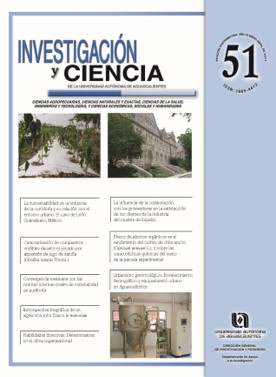Characterization of volatile compounds during watermelon juice (Citrullus lanatus Thunb.) spray drying
x
DOI:
https://doi.org/10.33064/iycuaa2011516804Keywords:
Citrullus lanatus Thunb., volatile compounds, gas chromatography, simultaneous distillation-extraction, powder product, spray dryingAbstract
The objetive of this experiment was to evaluate the effect of maltodextrin and gum Arabic on retention of maltodextrin and gum arabic on the retention of volatile compounds during spray drying of watermelon juice (Citrullus lanatus Thunb.). We used watermelon variety Alena. Three treatments were evaluated for encapsulating, T1: 0.5% w/w of maltodextrin, T2: 0.5% w/w Arabic gum and T3: 0.5% of a mixture of maltodextrin DE-10 and gum arabic (1:1) w/w. The drying conditions were constant: power flow of 15% of watermelon juice, drying temperature of 190 °C and outlet temperature of 80 °C. The volatile compounds from watermelon samples (before and after drying), were identified and quantified, using simultaneous distillation-extraction (SDE) and gas chromatography-mass spectrometry (GC-MS). It was determined that the best treatment was T3 based on the major retention of compounds (isoamyl acetate, decanol, phenylpropyl alcohol and phenylethyl alcohol).
Downloads
References
• AOAC, Official methods of analysis. 18th Association of Official Analytical Chemists. U.S.A., 1996.
• BEAULIEU, J.C. and C.C. GRIMM, Identification of Volatile Compounds in Cantaloupe at Various Developmental Stages Using Solid Phase Microextraction. Journal of Agricultural and Food Chemistry, 49(3): 1345-1352, 2001. DOI: https://doi.org/10.1021/jf0005768
• BEAULIEU, J.C. and J.M. LEA, Characterization and Semiquantitative Analysis of Volatiles in Seedless Watermelon Varieties Using Solid-Phase Microextraction. Journal of Agricultural and Food Chemistry, 54: 7789-7793, 2006. DOI: https://doi.org/10.1021/jf060663l
• GARCÍA, P.F. y H. MIRAFUENTES, Manual de producción de sandía de humedad residual en el Estado de Tabasco. Tabasco: INIFAP-SARH, 16 pp., 1993.
• GONZÁLEZ PALOMARES, S., et al., Análisis de compuestos volátiles en cilantro (Coriandrum sativum L.). Revista Acta Universitaria, 20(1): 19-24, 2010. DOI: https://doi.org/10.15174/au.2010.70
• GONZÁLEZ PALOMARES, S., et al., Comparación de dos métodos de extracción de compuestos volátiles en sandía (Citrullus lanatus T.). Revista Quehacer Científico en Chiapas, 1(7): 23-27, 2009.
• GONZÁLEZ PALOMARES, S., Secado por aspersión de noni (Morinda citrifolia L.). Revista UNACAR Tecnociencia, 3(1): 47-57, 2009.
• HINOJOSA, S.R., Experiencias obtenidas en el ensayo de rendimiento de seis variedades de sandía (Citrullus vulgaris) en la zona de la Chontalpa, Tabasco. Tesis profesional. Colegio Superior de Agricultura Tropical, H. Cárdenas. Tabasco, 60, 1983.
• HUI, L.Y., et al., Encapsulization of Channa striatus extract by Spray Drying Process. Journal of Applied Sciences, 10(21): 2499 2507, 2010. DOI: https://doi.org/10.3923/jas.2010.2499.2507
• IBARRA, J.L., y V.J. FLORES, Acolchado plástico, cubiertas flotantes y desarrollo y rendimiento de sandía y calabacita. Revista Agrociencia, 31,9-14, 1997.
• LIKENS, S.T., and G.B. NICKERSON, Detection of certain hop oil constituents in brewing products. Proc. Am. Soc. Brew. Chem., 5-13, 1964. DOI: https://doi.org/10.1080/00960845.1964.12006730
• LÓPEZ, H.O.D. et al., Características del aceite de semillas de Cucurbita pepo L. microencapsulado mediante secado por aspersión con maltodextrina y goma arábiga. Latin American Journal of Pharmacy, 28(4): 628- 632, 2009.
• MARÍN, L.J.C. y C.L. CÉSPEDES, Compuestos volátiles de plantas. Origen, emisión, efectos, análisis y aplicaciones al agro. Revista Fitotecnia Mexicana, 30(4): 327- 351, 2007. DOI: https://doi.org/10.35196/rfm.2007.4.327
• MASTERS, K., Spray Drying Handbook. 3 ed., New York: Halsted Press, 687, 1979.
• MASTERS, K., Spray Drying Handbook. 4 ed., England: George Godwin Ltd., 1985.
• MOURTZINOS, I., et al., Encapsulation of olive leaf extract in β-cyclodextrin. Journal of Agricultural and Food Chemistry, 55: 8088-8094, 2007. DOI: https://doi.org/10.1021/jf0709698
• NAYAR, N.M., and T.A. MORE, Cucurbits. Enfield, New Hampshire, USA: Science Publishers, Inc., 340 pp., 1998.
•QUEK, S.Y., et al., The physicochemical properties of spray-dried watermelon powders. Chemical Engineering and Processing, 46(5): 386-392, 2007. DOI: https://doi.org/10.1016/j.cep.2006.06.020
• SALAYA, D.J.M., et al., Propuesta del cultivo de la sandía (Citrullus vulgaris) al potencial del agua en el suelo. Revista Fitotecnia Mexicana, 127-133, 2002.
• SAS, Statistical Analysis System, Replace 8.0. Cary, NC; U.S.A., SAS Institute Inc., 1999.
•SCHULTZ, T.H. et al., Isolation of volatile components from a model systems. Journal of Agricultural and Food Chemistry, 25(3): 446-449, 1977. DOI: https://doi.org/10.1021/jf60211a038
•SISIDO, K., et al., Synthesis of gamma-Oxosenecioates, Flavor of Watermelon. Journal of American Chemical Society, 82: 2286-2288, 1960. DOI: https://doi.org/10.1021/ja01494a046
• VALDIVIEZO MACÍAS, J.A., Extracción del Carotenoide Licopeno a partir de los Rechazos Post Cosecha del Mercado Interno de Citrullus lanatus (sandía) para su futura aplicación en alimentos. Tesis de Ingeniero en Alimentos, Escuela Superior Politécnica del Litoral, Guayaquil – Ecuador, 129, 2010.
• YAJIMA, I., et al., Volatile Flavor Components of Watermelon (Citrullus vulgaris). Journal of Agricultural and Biological Chemistry, 49(11): 3145-3150, 1985. DOI: https://doi.org/10.1080/00021369.1985.10867246
• YÁÑEZ-FERNÁNDEZ, J., et al., Aplicaciones biotecnológicas de la microencapsulación. Avance y Perspectiva, 21: 313-319, 2002.
Downloads
Published
How to Cite
License
Copyright (c) 2011 Héctor Manuel González-Sánchez, Salvador González- Palomares, Tábata Rosales-Reyes

This work is licensed under a Creative Commons Attribution-NonCommercial-ShareAlike 4.0 International License.
Las obras publicadas en versión electrónica de la revista están bajo la licencia Creative Commons Atribución-NoComercial-CompartirIgual 4.0 Internacional (CC BY-NC-SA 4.0)









